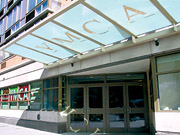
Even though the 150-year-old YMCA of Greater New York has 21 indoor pools at its 19 branches and 200 facilities that serve 330,000 people citywide, the McBurney Y's natatorium has become the community service organization's state-of-the-art aquatic showpiece.
"The McBurney Y pool is now the most state-of-the-art pool in our (YMCA of Greater New York) group and as far as prospective members joining, it appears to be this pool that impresses them the most," said Edward Lane, director of facility operations for the McBurney Y.
The natatorium's stunning four-wall glass design by Richard Dattner & Partners Architects (New York), allows joggers on the perimeter running track, members' lounge, and other athletic activity users throughout the two-story building to see the 25-meter/7-lane indoor pool's activities. Dattner's design even lures people outside on 14th Street, which offers unobstructed views through the contemporary lobby and into the pool area. "I've personally talked to new members who were drawn into the facility by the view into the space and specifically the pool," said John Woelfling, partner with Richard Dattner Partners Architects.
Condensation minimization
With windows playing such an important part in the pool's interior design, dehumidifying the space and keeping its glass clear of condensation became a top priority for Dattner's HVAC design team and J.T. Falk Co., LLC, a New York-based mechanical contractor that installed the HVAC systems under the guidance of the project's general contractor, Humphreys & Harding Inc.
Dattner specified a custom-manufactured Dectron Internationale Dry-O-Tron(r) DS-282 heat recovery dehumidifier that removes a capacity of 280 lb of moisture an hour from the natatorium space while also cooling or heating it to 82 degreesF. Pool water is currently heated to 84 degrees by a York-Shipley Global boiler, however a pool water heat exchanger specified in the Dry-O-Tron can later be connected to add more efficient pool water heating through Dectron's proprietary heat recovery process, according to Robert Senia, president SRS Enterprises, a Brooklyn-based manufacturer's representative.
An atypical airflow design
Dattner collaborated with J.T. Falk on an air distribution system that eliminates air stratification without blowing chilling drafts onto swimmers. The airflow design calls for concealed galvanized supply air duct with directional outlets 12 ft above the pool deck and evenly spaced along the perimeter, but just below the windows so as not to obstruct any views. While many natatorium airflow designs simply use a wall grille for return air, Dattner's design uses four 25-in.-dia and one 18-in.-dia return air branches and 13 registers integrated between the roof joists to draw humid air and chloramines back to the dehumidifier. "This design ensures the air is moved evenly throughout the facility without any stratification, drafts, or condensation build-ups," explained Woelfling.The 18,500-cfm system completely recirculates and conditions pool space air eight times per hour. The system also introduces approximately 25% outside air in accordance with IAQ design parameters for a 187-occupant capacity as recommended by ASHRAE standards. When the pool is periodically super-chlorinated to comply with public pool sanitizing standards, the dehumidifier was custom designed with a remote purge fan that switches to 100% outside air.
One challenge Dattner and J.T. Falk faced on the project was limited mechanical room space. Square footage is a premium in Manhattan, so the dehumidifier was ordered to be custom-built nearly two feet shorter. Although it's more compact, the dehumidifier still includes many options such as a heating coil for pool water heating and a water-cooled condenser that taps off of the building's chilled water loop that is supplied by two York International chillers. Typically, mechanical dehumidifiers use cooling towers, but because of the limited space at McBurney, this system efficiently uses the chilled water loop for condensing.
The mechanical room's confinement was challenging as well for the project's mechanical and sheet metal contractor, J.T. Falk, which had to partially disassemble the Dry-O-Tron on site and then assemble it inside the mechanical room, recalled Arnold Robinson, executive vice president for J.T. Falk.
The differences between the original 20-ft-by-40-ft, 50,000-gal McBurney Y pool 10 blocks away, and the current state-of-the-art natatorium at the new location are significant, according to Lane. "Here at the new facility, members are pleased with the air temperature and comfortable relative humidity when they are in and out of the pool, even though it's at least four times larger," Lane added.ES
